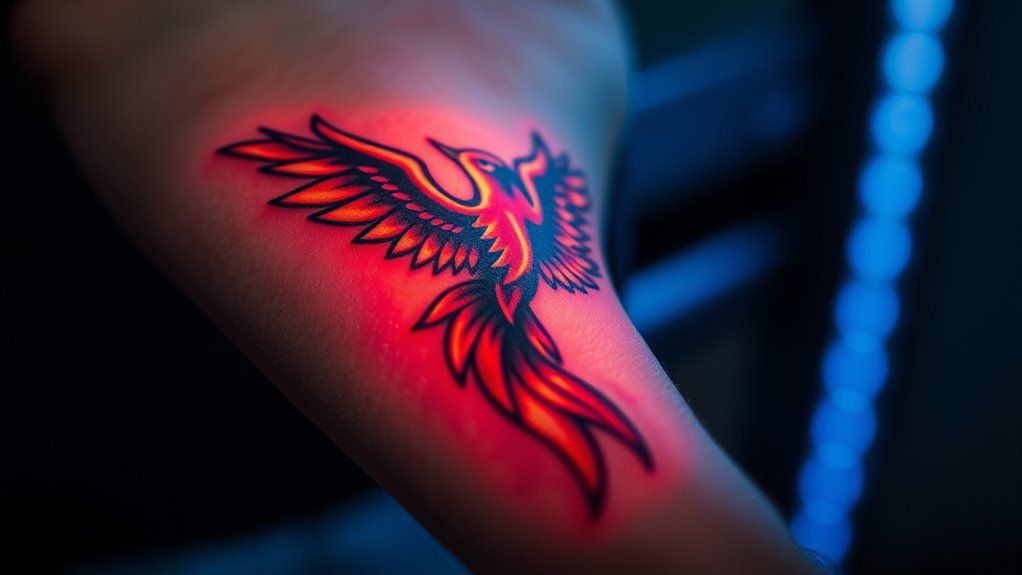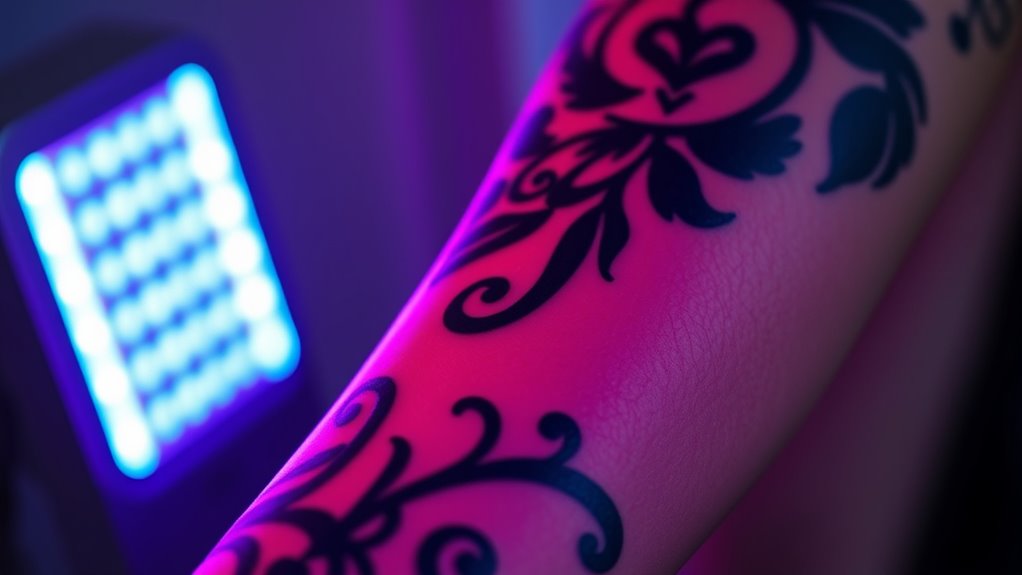Embedding LEDs into your skin carries significant safety concerns. You should use only medical-grade, certified components and follow strict sterilization procedures to reduce infection risks. Be aware that your immune system may react to the electronics, causing inflammation or allergies. Removing embedded LEDs can be complex and might leave scars. To make safe choices, understand the long-term effects, consult professionals, and stay informed about the latest safety guidelines—there’s much more to contemplate before proceeding.
Key Takeaways
- Use medical-grade, certified electronic components and follow strict sterilization protocols to minimize health risks.
- Consult healthcare professionals to assess allergies and skin compatibility before getting LED tattoos.
- Ensure practitioners adhere to hygiene standards and use sterilized tools to prevent infections.
- Be aware that LED removal can be complex, potentially causing scarring or nerve damage; consider long-term safety.
- Stay informed about emerging research and prioritize reputable providers to make safe, well-informed decisions.

Have you ever wondered how LED technology is transforming the world of tattoos? It’s an exciting development that offers new possibilities for creative expression, but it also raises important safety considerations you need to be aware of. Unlike traditional inks, LED tattoos involve integrating tiny light-emitting diodes into the skin, which can be activated to produce various lighting effects. While this innovation can make your tattoo unique and dynamic, it’s essential to understand the potential risks involved and how to protect yourself.
First, safety starts with the quality of the materials used. Since LED tattoos involve electronic components, you must ensure they’re medical-grade and specifically designed for implantation. Poorly manufactured or uncertified devices can lead to infections, allergic reactions, or tissue damage. Always seek out reputable artists and clinics that follow strict sterilization protocols and use certified products. Don’t cut corners by choosing cheaper, unverified options—your health depends on it.
Another key consideration is the body’s reaction to foreign objects. Your immune system might recognize the LEDs or their wiring as threats, leading to inflammation or rejection. Some people may develop allergic responses to the materials used in the LEDs or their encapsulating substances. Before proceeding, consult with a qualified dermatologist or medical professional to assess your skin’s compatibility and discuss any allergies you might have. A thorough evaluation can help prevent adverse reactions down the line.
Infection control is paramount. Since LED tattoos involve invasive procedures, there’s a risk of bacterial contamination if the equipment isn’t sterile. This can cause serious infections, which may require antibiotics or even surgical intervention. Make sure the tattoo artist or technician adheres to strict hygiene standards, including using sterilized tools and disposable supplies where applicable. Follow all aftercare instructions diligently—keeping the area clean, avoiding exposure to dirt or water, and monitoring for signs of infection.
Long-term safety also involves considering what happens if the LEDs malfunction or need removal. The removal process can be complicated, involving surgical procedures that carry their own risks, such as scarring or nerve damage. Additionally, the long-term effects of having electronic components embedded in your skin aren’t fully understood yet. It’s wise to weigh these factors carefully and discuss all concerns with medical professionals before getting an LED tattoo.
Furthermore, staying informed about emerging technologies and ongoing research can help you make safer choices about body modifications involving electronics. Ultimately, embracing LED tattoos requires balancing creativity with caution. By prioritizing safety, choosing reputable providers, and staying informed about potential risks, you can enjoy the innovation without compromising your health. Remember, a tattoo is a permanent decision—making sure it’s safe and well-considered ensures that your body remains healthy and your expression remains vibrant.
Frequently Asked Questions
Can LED Tattoos Cause Allergic Reactions?
Yes, LED tattoos can cause allergic reactions. The dyes and materials used in LED ink might trigger sensitivities in your skin, leading to redness, itching, or swelling. Since LED tattoo inks are less common, the risk of allergic responses isn’t fully understood, so it’s essential to consult with a professional and perform patch tests beforehand. If you experience any adverse reactions, seek medical advice promptly.
Are LED Tattoos Permanent or Temporary?
LED tattoos are generally temporary because the LED lights are embedded in a way that allows them to be removed or fade over time. Unlike traditional ink tattoos, which are permanent, LED tattoos often use detachable or wearable components that can be taken off or stop functioning. The longevity depends on the specific design and materials used, but most LED tattoos are intended to be short-term or reusable.
What Are the Long-Term Health Risks of LED Tattoos?
Did you know that research shows only 30% of new tattoo inks are fully tested for safety? Long-term health risks of LED tattoos include potential skin irritation, allergic reactions, and unknown effects from embedded electronic components. These risks could increase over time as the body interacts with the LEDs or if the device malfunctions. You should stay informed and consult a healthcare professional before getting such innovative tattoos.
How Do LED Tattoos Affect MRI Scans?
LED tattoos can interfere with MRI scans because the electronic components might heat up or malfunction during the procedure. You could experience discomfort, or the tattoo could distort the MRI images, making diagnosis difficult. It’s important to inform your medical team about your LED tattoo before an MRI. They can take precautions or suggest alternative imaging methods to guarantee your safety and obtain accurate results.
Are There Age Restrictions for Getting LED Tattoos?
Think of LED tattoos like a garden that requires careful planning—age restrictions act as the gardener’s rulebook. You typically need to be at least 18, or with parental consent, to get one. This ensures you’re mature enough to understand the process and potential risks. Just as a garden thrives with proper care, your decision to get an LED tattoo should be made responsibly, respecting age limits for safety.
Conclusion
Remember, safety always comes first—don’t cut corners when it comes to LED treatments or tattoos. Always do your research, follow all guidelines, and listen to your body. As the saying goes, “Better safe than sorry.” By staying informed and cautious, you can enjoy your new look without unnecessary risks. Prioritize your health, and make sure your choices are as bright and lasting as your new tattoos and LED experiences.









